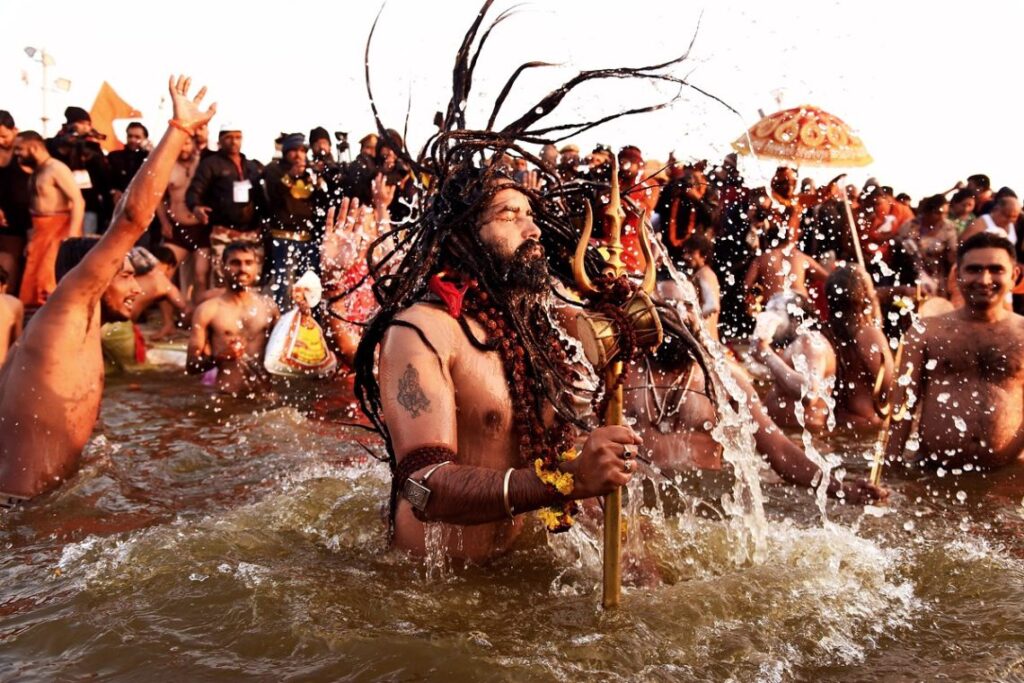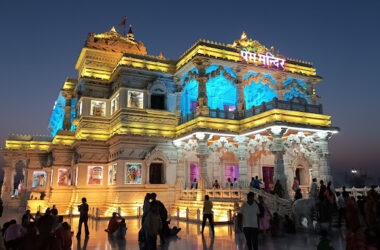The next Kumbh Mela will be held in 2021 in Haridwar, a religious event that will be attended by millions of devotees around the world. The Kumbh Mela is held at one of the four holy pilgrimage destinations, Haridwar, Nashik, Allahabad, and Ujjain, every 12 years by rotation. The dates for a pilgrimage to the Kumbh Mela are determined according to the Vikram Samvat calendar. At the Kumbh Mela Haridwar, millions of people will gather to take a dip in the holy River Ganges. The dates for the Kumbh Mela 2021 have been announced. Kumbh Mela 2021 will begin on 14th January, on the auspicious occasion of Makar Sankranti. The first Shahi Snan will take place on 11th March, and the second and third ones on 12 and 14th April respectively. The fourth Shahi Snan will be held on 27th April, and on the same day, the Haridwar Kumbh Mela 2021 will come to an end.
Haridwar Kumbh Mela
Bathing Dates – 2021
The dates for the Kumbh Mela 2021 in Haridwar have been declared, it will be attended by millions of pilgrims and devotees from India, as well as the world. It will be a momentous occasion, marked by observations of various rituals, traditions, and ceremonies. These include mass feeding, religious discussions, and devotional singing. Exchange of religious knowledge and scriptures is carried on, while laymen seek blessings of devotees. The size and scale of the event have led it to be included as a UNESCO Intangible Cultural Heritage.
Kumbh Mela, the largest religious gathering in the world, is held every 12 years in rotation at the four holy places of Haridwar, Allahabad, Ujjain and Nasik. The 2021 Maha Kumbh Mela will be held at Haridwar. It will witness the coming together of millions of pilgrims, accompanied by sadhus and different akharas, to take a dip in the holy River Ganges. The bathing dates for this mega event have already been announced and they are mentioned below.
January 14 to April 27, 2021
- Makar Sankranti (Snan) 14 January 2021
- Mauni Amavasya (Snan) 11 February 2021
- Basant Panchami (Snan) 16 February 2021
- Magh Poornima 27 February 2021
- Maha Shivratri (Shahi Snan) 11 March 2021
- Somvati Amamvasya (Shahi Snan) 12 April 2021
- Baisakhi (Shahi Snan) 14 April 2021
- Ram Navami (Snan) 21 April 2021
- Chaitra Purnima (Shahi Snan) 27 April 2021
Kumbh Mela | About
Crazy and chaotic are the words that best define the Kumbh Mela. Amidst the intermittent chanting of mantras, the heart rendering dance of the Aghoris, and the holy ghats lit up with fiery diyas, you will have no chance but to go with the flow. The Kumbh Mela, will not just lend you with a day’s feeling but a mind-boggling experience of a lifetime.
Swarming like fireflies towards a bulbous giant, millions of zealous devotees come together to wash their sins during the Kumbh Mela. The origin of these mammoth spiritual gatherings can be traced back to the existence of Demons and Gods on earth. As per the Hindu mythology, Kumbh derived from the Sanskrit word ‘pitcher’ had the ‘Amrita’ the immortal nectar that had appeared during the ‘Samudra Manthan’. It is believed that the Gods and the demons had churned the milky ocean to obtain the same.
One of the most euphoric religious events in India, the Kumbh Mela is celebrated four times every twelve years. Herds of sadhus and devotees crowd the sanctified pavilions to be a part of the ‘world’s massive act of faith.’ Kumbh Mela is considered the most auspicious time to take a dip in the sacred river to free themselves from their sins and attain a step forward towards salvation. The most popular draws of the mela are the Nagas (naked sadhus), Urdhawavahurs (who expose their bodies to extreme austerities), and the Kalpwasis (the ones who bathe three times a day). Apart from these, the rituals that are performed during this time are worth witnessing.
The Kumbh Mela observes the World’s largest peaceful gathering at some of the very significant destinations in the history of Hinduism. Haridwar (river Ganga), Prayag (Triveni Sangam of Yamuna, Ganga, and Saraswati), Ujjain (river Kshipra), and Nasik (river Godavari) are the Kumbh Mela Destinations which are said to be eternally blessed during this time. Enthusiastic Travelers and ardent roamers who yearn to explore the Cultural Heritage of India can be part of the incessant hysteria at the Kumbh.
Guidelines for Tourists Visiting Kumbh Mela in 2021
Haridwar will host the Kumbh Mela from 14th January in 2021. It will be attended by millions of devotees, including sadhus. The government, therefore, has come up with a set of COVID-19 guidelines which will have to be followed by devotees and tourists visiting the Kumbh Mela. These guidelines are mentioned below:
- Devotees and tourists visiting the Kumbh Mela will have to carry a negative COVID-19 RT-PCR report. The report should have a test date 72 hours before the date of the visit.
- Use of face covers or masks will be compulsory.
- All devotees will have to register with the government of Uttarakhand.
- Devotees & tourists will also have to obtain a compulsory medical certificate in their state from the nearest Community Health Center/District Hospital/Medical College.
- Those who are above 65 years of age, or senior citizens, pregnant women, children below 10 years of age, and those with comorbid conditions like diabetes, hypertension, chronic lung disease, and cancer should avoid visiting the Kumbh Mela.
- Individuals should always maintain a distance of 6 feet from each other at all times.
- Wash your hands frequently with soap, even when they do not look dirty. Alcohol-based sanitizers will be made available.
- Spitting is strictly prohibited.
- Aarogya Setu app should be installed by everybody.
These are some of the guidelines and rules which will have to be observed by everybody visiting the Kumbh Mela in Haridwar.
Frequently Asked Questions
Q: What is Kumbh Mela?
Ans: Kumbh Mela is a major pilgrimage of Hindus. It is the largest religious gathering of Hindus held four times over the course of 12 years at 4 different locations that are situated on the bank of the sacred rivers. Prayagraj (at the confluence of the Ganga, Yamuna, and Saraswati Rivers), Ujjain (River Shipra), Haridwar (River Ganga), and Nasik (River Godavari) are the four destinations.
Q: Why is Kumbh Mela celebrated?
Ans: It is believed, the nectar from the pot fell at four locations – Prayagraj, Ujjain, Haridwar, and Nasik during an epic battle between the gods and the demons. At these four places, Kumbh Mela takes place. The Hindu devotees throng these places with a belief that a dip in the waters of the sacred rivers will wash away all their sins.
Q: What is Ardh Kumbh Mela?
Ans: The Ardh Kumbh Mela (Half Kumbh Mela) is held every 6 years in two different locations, Allahabad and Haridwar. Ardh means ‘half’ which is interpreted as the half of 12 years.
Q: What is Mahakumbh?
Ans: The Maha Kumbh Mela is held every 144 years at Prayagraj (Allahabad), after the completion of 12 Purna Kumbh Melas. The Purna Kumbh Mela is held every 12 years and hence, the Maha Kumbh Mela is held every 144 years (12*12=144).
Q: Why is Kumbh Mela held every 12 years?
Ans: The war between the gods and the demons over the possession of the Nectar of Immortality lasted for 12 divine days which are equivalent to 12 human years. Therefore, the Kumbh Mela or more commonly called Purna Kumbh Mela is held every 12 years at the 4 holy sites.
Q: In which places is the Kumbh Mela celebrated?
Ans: The Kumbh Mela is held in Prayagraj (at the confluence of Ganga, Yamuna and Saraswati Rivers), Nasik (River Godavari), Ujjain (River Shipra) and Haridwar (River Ganga).
Q: What is the religious significance of Kumbh Mela for devotees of Hinduism?
Ans: The Hindu devotees believe that a visit to the auspicious Kumbh Mela and a dip in the river will cleanse them from all their sins.
Q: What are the main attractions of Kumbh Mela?
Ans: The major attractions of the Kumbh Mela are: a holy bath in the sacred river that is believed to cleanse one from all their sins; the sacred Aartis on the banks of the river accompanied by the prayers and hymns chanted by the priests, the Pravachan, Kirtan, Mahaprasad and the Naga Sadhus.
Q: Who are Naga Sadhus?
Ans: The Naga Sadhus are the followers of Lord Shiva. They don’t wear any clothes and live an ascetic life having relinquished all their desires for body, comfort and material.
Q: Where do Naga Sadhus live?
Ans: The Naga Sadhus live in the caves of the Himalayas, away from the contact of human civilization, and meditate there in order to seek enlightenment and salvation.
Q: Can we meet Naga Sadhus?
Ans: Yes, one can meet the Naga Sadhus in the Kumbh Mela. You can click their pictures, talk to them and get an insight into their lives and experiences after asking for their permission. However, if they refuse, then it is advised to respect their decision and leave them alone.
Q: Why don’t Naga Sadhus wear clothes?
Ans: The Naga Sadhus have given away all their desires for material and body and live an ascetic life in order to seek spiritual enlightenment and salvation. This is the reason behind them not wearing any clothes which are a symbol of attachment to the materialistic possessions of the world.
Q: What is the nearest airport, railway station and bus terminal to Kumbh Mela, Haridwar?
Ans: The nearest Airport to Haridwar is the Jolly Grant Airport in Dehradun (41 km away). The airport has direct flights operating from Dehradun to major cities like Delhi and Mumbai and connecting flights to all the cities of India. One can hire a cab from outside the airport to go to Haridwar.
Haridwar has its own railway station that connects it to the rest of the country. It enjoys good rail connectivity with the major cities of India like Delhi, Kolkata, Mumbai, Dehradun, Jaipur, Patna, and many others.
Similar Post – Kedarnath – Home of Lord Shiva











